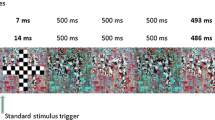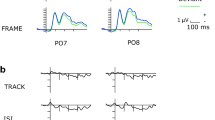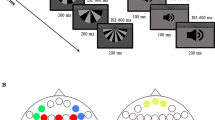Abstract
Event-related potentials were measured in 12 healthy youth subjects aged 19–22 using the paradigm “cross-modal and delayed response” which is able to improve unattended purity and to avoid the effect of task target on the deviant components of ERP. The experiment included two conditions: (i) Attend visual modality, ignore auditory modality; (ii) attend auditory modality, ignore visual modality. The stimuli under the two conditions were the same. The difference wave was obtained by subtracting ERPs of the standard stimuli from that of the deviant stimuli. The present results showed that mismatch negativity (MMN), N2b and P3 components can be produced in the auditory and visual modalities under attention condition. However, only MMN was observed in the two modalities under inattention condition. Auditory and visual MMN have some features in common: their largest MMN wave peaks were distributed respectively over their primary sensory projection areas of the scalp under attention condition, but over frontc-central scalp under inattention condition. There was no significant difference between the amplitudes of visual and auditory MMN. Their amplitudes and the scalp distribution were unaffected by attention, thus suggesting that MMN amplitude is an important index reflecting automatic processing in the brain. However, the latency of the auditory and visual MMN were affected by attention, showing that MMN not only reflects automatic processing but also probably relates to control processing.
Similar content being viewed by others
References
Naatanen, R.,Attention and Brain Function, New Jersey: Hillsdale, 1992.
Woldorff, M, G.. Hackley, S, A., Hillyard, S, A., The effects of channel-selective attention on the mismatch negativity wave elicited by deviant tones,Psychophysiology, 1991, 28: 30.
Näätänen, R., Paavilainen, P., Tiitinen, H.et al., Attention and mismatch negativity,Psychophysiology, 1993, 23: 436.
Ciesielski, K, T., Knight, J. E., Prince, R. J.et al., Event-related potentials in cross-modal divided attention in autism,Neuropsychologia, 1995, 33: 225.
Cammann, R., Is there a mismatch negativity in the visual modality?Behavioral and Brain Sciences, 1990, 13: 234.
Wei, J. H., The paradigm of simultaneous-like stimuli and delayed response, and its role in ERP research,J. of Developments in Psychology (in Chinese), 1995, 3(4): 28.
Cheng, C. M., Fu, G. L., The recognition of Chinese characters and words under divided visual-field presentation, inLinguistics, Psychology and the Chinese Language (eds. Kao, H. S. R., Hoosain, R.), Hong Kong: Hong Kong University press, 1986.
Polich, J., Meta-analysis of P300 normative aging studies,Psychophysiology, 1996, 33: 334.
Woods, D. L., Alho, K., Algazi, A., Intermodal selective attention I—Effects on event-related potentials to lateralized auditory and visual stimuli,Electroenceph. Clin. Neurophysiol., 1992, 82: 341.
Alho, K., Woods, D. L., Algazi, A., Processing of auditory stimuli during auditory and visual attention as revealed by eventrelated potentials,Psychophysiology, 1994, 31: 469.
Czigler, I., Csibra, G., Event-related potentials in a visual discrimination task,Psychophysiology, 1990, 27: 669.
Hackley, S. A., Woldorff, M. G., Hillyard, S. A., Cross-modal selective attention effects on retinal, myogenic, brainstern, and cerebral evoked potentials,Psychophysiology, 1990, 27: 195.
Hohnsbein, J., Falkenstein, M., Hoormann, J.et al., Effects of crossmodal divided attention on late ERP components,Electroenceph. Clin. Neurophysiol., 1991, 78: 438.
Winkler, I., Paavilainen, P., Näätänen, R., Can echoic memory store two traces simultaneously? A study of event-related brain potentials,Psychophysiology, 1992, 29: 337.
Author information
Authors and Affiliations
Additional information
Project supported by the National Natural Science Foundation of China.
Rights and permissions
About this article
Cite this article
Luo, Y., Wei, J. Mismatch negativity of ERP in cross-modal attention. Sci. China Ser. C.-Life Sci. 40, 604–612 (1997). https://doi.org/10.1007/BF02882690
Received:
Issue Date:
DOI: https://doi.org/10.1007/BF02882690




